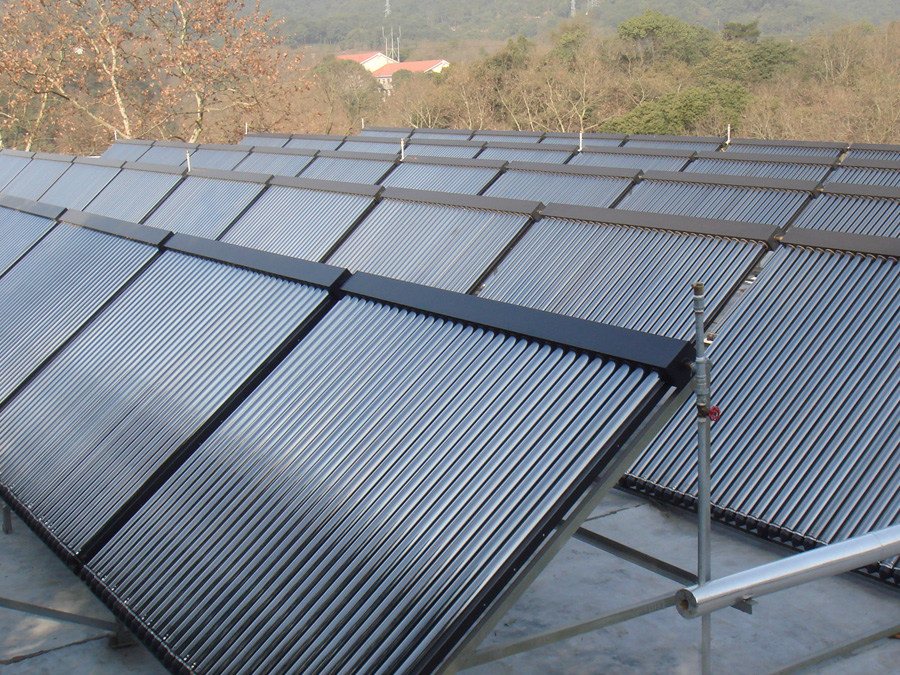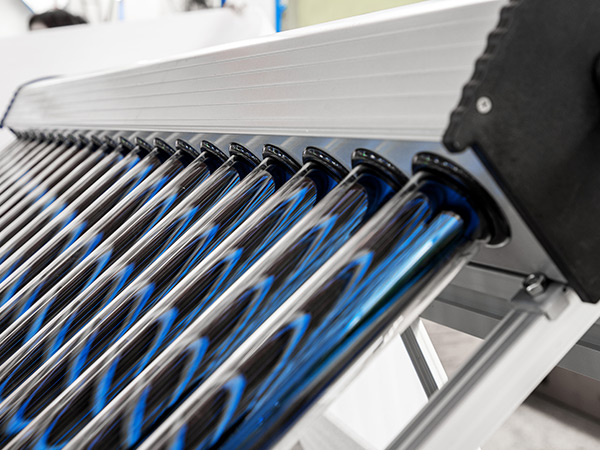
Heat Pipe Collector
Heat pipe solar collectors are a type of solar thermal collector that use advanced heat pipe technology to efficiently capture and transfer solar energy.
These collectors are widely used for a variety of applications, such as hot water generation, space heating, and industrial process heat, and are known for their high efficiency, durability, and low maintenance requirements.
In this section, we will explore the basic design and operating principles of heat pipe solar collectors and discuss their advantages, disadvantages, and applications.

Design and Construction
Heat pipe solar collectors consist of a series of evacuated glass tubes that contain a copper heat pipe running through the center of each tube. The heat pipe is filled with a small amount of water or other working fluid, and is sealed at both ends with a wick-like material that helps to transport the fluid through the pipe.
The outer surface of each glass tube is coated with a special material that allows sunlight to pass through while minimizing reflection and absorption. This coating, along with the vacuum inside the tube, helps to trap solar energy and prevent heat loss.

Working Principle
The working principle of heat pipe solar collectors is based on the concept of thermosyphoning. When the collector is exposed to sunlight, solar energy is absorbed by the coating on the outer surface of the glass tube. This energy heats up the copper heat pipe inside the tube, causing the water or working fluid inside the pipe to evaporate and turn into a vapor.
As the vapor rises through the heat pipe, it reaches the heat exchanger at the top of the collector, where it releases its heat to the fluid circulating through the system. This process of heat transfer is very efficient, as the heat is transferred directly from the vapor to the fluid without any need for pumps or external energy sources.
After releasing its heat, the vapor condenses back into a liquid and flows back down the heat pipe to the bottom of the collector, where it is heated again by the solar energy. This cycle of evaporation and condensation continues as long as the collector is exposed to sunlight, creating a continuous flow of heated fluid.
Because the heat pipe is sealed and operates in a vacuum, heat loss from the collector is minimized, making it an efficient way to capture and transfer solar energy.

Types of Heat Pipe Collectors
There are two main types of heat pipe solar collectors:
Single Heat Pipe Collector: In this type, each glass tube contains only one heat pipe. The heat pipe is inserted into a heat exchanger at the top of the collector, and the fluid being heated flows through the heat exchanger to absorb the heat.
Dual Heat Pipe Collector: In this type, two heat pipes are inserted into each glass tube. The heat pipes are connected to a manifold at the top of the collector, which allows for greater heat transfer and a higher overall efficiency.
Both types of heat pipe collectors can be used for residential and commercial applications, but the dual heat pipe collectors are generally more efficient and are better suited for larger scale systems.
Applications
Heat pipe collectors can be used in various applications including:
Hot Water Systems: Heat pipe collectors can be used to provide hot water for residential and commercial buildings.
Space Heating: Heat pipe collectors can be used to provide heat for space heating systems in residential and commercial buildings.
Industrial Processes: Heat pipe collectors can be used to provide heat for various industrial processes such as drying, pasteurization, and sterilization.
Solar Cooling: Heat pipe collectors can be used in combination with absorption chillers to provide solar cooling for buildings.
Agricultural Applications: Heat pipe collectors can be used for crop drying, greenhouse heating, and water heating for livestock.
Overall, heat pipe collectors are versatile and can be used in a wide range of applications where solar energy can be harnessed to provide heat.
Advantages and Disadvantages
Advantages of Heat Pipe Collectors:
High Efficiency: Heat pipe collectors are more efficient than other types of solar collectors due to the use of heat pipes, which have a high heat transfer coefficient.
Temperature Resistance: Heat pipe collectors can withstand high temperatures without any damage, making them suitable for use in areas with high ambient temperatures.
Low Maintenance: Heat pipe collectors have a simple design and require very little maintenance.
Rapid Heat Transfer: Heat pipe collectors can quickly transfer heat from the collector to the water or fluid being heated.

-
Cost: Heat pipe collectors can be more expensive than other types of solar collectors due to their advanced design and use of heat pipes.
-
Complexity: Heat pipe collectors are more complex than other types of solar collectors, which can make installation more challenging.
-
Susceptibility to Freezing: Heat pipe collectors can be susceptible to freezing in colder climates, which can damage the heat pipes and reduce efficiency.
-
Fragility: Heat pipe collectors can be more fragile than other types of solar collectors due to their design, which can make them more prone to damage from impacts or other physical stresses.
Overall, heat pipe collectors offer several advantages over other types of solar collectors, but they can also have some limitations that need to be considered when choosing a solar collector for a specific application.
Comparison with Other Types of Solar Collectors
When compared with other types of solar collectors, heat pipe collectors offer several advantages and disadvantages.
Compared to flat plate collectors, heat pipe collectors are more efficient, especially in high-temperature applications, due to their use of heat pipes that have a high heat transfer coefficient. Heat pipe collectors also have a lower profile and can be mounted on rooftops or walls, making them a good choice for limited space applications. However, heat pipe collectors can be more expensive and more complex to install and maintain than flat plate collectors.
Compared to evacuated tube collectors, heat pipe collectors have a simpler design and require less maintenance, making them easier to install and operate. Heat pipe collectors also have a lower profile and can be mounted on rooftops or walls. However, evacuated tube collectors may be more efficient in colder climates due to their ability to retain heat and resist freezing, while heat pipe collectors may be more prone to freezing and damage in colder climates.
Overall, the choice between heat pipe collectors, flat plate collectors, and evacuated tube collectors depends on several factors, including the specific application, the available space, the local climate, and the budget. A professional solar installer can help determine the best solar collector type for a specific application.
Maintenance and Repair

Like any other solar collector, heat pipe collectors require regular maintenance to ensure optimal performance and longevity. Here are some important maintenance and repair considerations for heat pipe collectors:
Keep the collector clean: Dirt, dust, and debris can accumulate on the collector and reduce its efficiency. Clean the collector periodically, using a soft brush or sponge and mild soap and water. Avoid using abrasive materials or harsh chemicals, which can scratch or damage the collector.
Check for leaks: Inspect the collector for leaks, especially around the seams and joints. If you notice any leaks, contact a professional solar installer to repair or replace the collector.
Inspect the insulation: The insulation around the heat pipes and collector should be in good condition and not damaged. Damaged insulation can result in heat loss and reduced efficiency. If you notice any damage, contact a professional solar installer to repair or replace the insulation.
Check the mounting system: The mounting system for the collector should be secure and in good condition. Inspect the mounting brackets and bolts regularly, and tighten them if necessary. If you notice any damage or looseness in the mounting system, contact a professional solar installer to repair or replace it.
Monitor the performance: Keep track of the collector’s performance over time, including its output and efficiency. If you notice a significant decrease in performance, contact a professional solar installer to diagnose and fix the problem.
Overall, regular maintenance and prompt repair of any issues can help ensure the long-term performance and efficiency of a heat pipe collector. A professional solar installer can provide specific maintenance and repair recommendations based on the manufacturer’s guidelines and the specific application.
Conclusion
The heat pipe collector is a highly efficient solar technology that uses a vacuum-sealed copper pipe to transfer heat from the absorber plate to a heat transfer fluid. Its design allows for quick heat transfer and low heat loss, making it ideal for use in various applications, including water heating and space heating.
While heat pipe collectors have many advantages, including their high efficiency and low maintenance, they also have some limitations, such as high initial costs and susceptibility to freezing in colder climates. Additionally, they may not be suitable for all applications and locations.
Overall, heat pipe collectors are a promising technology that can help to reduce reliance on fossil fuels and promote sustainable energy use. With ongoing research and development, these collectors may become even more efficient and cost-effective in the years to come.
